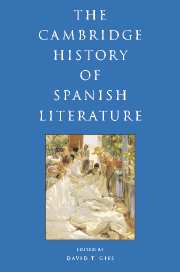Book contents
- Frontmatter
- I INTRODUCTION
- II HISTORY AND CANONICITY
- III THE MEDIEVAL PERIOD
- IV EARLY MODERN SPAIN: RENAISSANCE AND BAROQUE
- V THE ENLIGHTENMENT AND NEOCLASSICISM
- 17 Spain and Enlightenment
- 18 Eighteenth-century Neoclassicism
- 19 Eighteenth-century prose writing
- 20 Eighteenth-century poetry
- 21 Neoclassical versus popular theatre
- VI THE FORGING OF A NATION: THE NINETEENTH CENTURY
- VII THE MODERN, MODERNISMO, AND THE TURN OF THE CENTURY
- VIII TWENTIETH-CENTURY SPAIN AND THE CIVIL WAR
- IX IN AND OUT OF FRANCO SPAIN
- X POST-FRANCO SPANISH LITERATURE AND FILM
- Bibliography
- Index
- References
21 - Neoclassical versus popular theatre
from V - THE ENLIGHTENMENT AND NEOCLASSICISM
Published online by Cambridge University Press: 28 March 2008
- Frontmatter
- I INTRODUCTION
- II HISTORY AND CANONICITY
- III THE MEDIEVAL PERIOD
- IV EARLY MODERN SPAIN: RENAISSANCE AND BAROQUE
- V THE ENLIGHTENMENT AND NEOCLASSICISM
- 17 Spain and Enlightenment
- 18 Eighteenth-century Neoclassicism
- 19 Eighteenth-century prose writing
- 20 Eighteenth-century poetry
- 21 Neoclassical versus popular theatre
- VI THE FORGING OF A NATION: THE NINETEENTH CENTURY
- VII THE MODERN, MODERNISMO, AND THE TURN OF THE CENTURY
- VIII TWENTIETH-CENTURY SPAIN AND THE CIVIL WAR
- IX IN AND OUT OF FRANCO SPAIN
- X POST-FRANCO SPANISH LITERATURE AND FILM
- Bibliography
- Index
- References
Summary
At the beginning of the eighteenth century Spanish theatre had a well-established tradition of generic models, performing styles, theatrical conventions, and audience preferences. The imaginative power of Spain’s Golden Age theatre had resulted in some of the most seminal works in the history of drama, giving birth to mythical characters like don Juan or Celestina. The seventeenth-century stage was supremely responsive to the demands of audiences and developed in close conformity with the dominant mentality of Baroque Spain. Lope de Vega and Pedro Calderón de la Barca created a successful national dramatic tradition whose generic models and principles were followed by most other playwrights.
However, in 1701 a new dynasty ascended the Spanish throne, and the new king, Felipe V, introduced reform at all levels of national life. The idea of change became a constant of the new age and had innumerable repercussions for the theatre. Changes took place in the nation’s mental outlook, stimulated by new ideas, written texts, artistic modes, and scientific advances; the new dynasty stimulated changes in Spanish attitudes. The resulting turmoil is reflected most intensely in the theatre because it was the public forum with the deepest ideological significance, enjoying the widest popular favor. Initial confrontations arose out of the questioning of the national theatrical tradition, which promptly took on ideological connotations, but it was from the 1760s onwards that the change in atmosphere became most evident, with the existence of fierce public debate.
- Type
- Chapter
- Information
- The Cambridge History of Spanish Literature , pp. 333 - 342Publisher: Cambridge University PressPrint publication year: 2005



